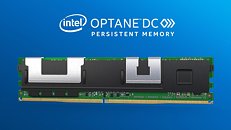- Joined
- Oct 9, 2007
- Messages
- 47,795 (7.40/day)
- Location
- Dublin, Ireland
| System Name | RBMK-1000 |
|---|---|
| Processor | AMD Ryzen 7 5700G |
| Motherboard | Gigabyte B550 AORUS Elite V2 |
| Cooling | DeepCool Gammax L240 V2 |
| Memory | 2x 16GB DDR4-3200 |
| Video Card(s) | Galax RTX 4070 Ti EX |
| Storage | Samsung 990 1TB |
| Display(s) | BenQ 1440p 60 Hz 27-inch |
| Case | Corsair Carbide 100R |
| Audio Device(s) | ASUS SupremeFX S1220A |
| Power Supply | Cooler Master MWE Gold 650W |
| Mouse | ASUS ROG Strix Impact |
| Keyboard | Gamdias Hermes E2 |
| Software | Windows 11 Pro |
Optane Persistent Memory is being touted by Intel as the "hottest" storage medium between DRAM and NVMe SSDs in the short-term, and a successor to DRAM-based memory in the long-term, aided by its ability to hold data even in the absence of power. The company's latest Xeon Scalable "Cascade Lake" processors support Optane Persistent Memory, allowing data-centers to cram larger amounts of data accessible at DRAM-like speeds, even if at much higher latencies. It remains significantly faster than NVMe SSDs. Component retails began listing 512 GB modules of the Optane Persistent Memory, and its prices are nothing like your 512 GB NVMe SSD. CompSource lists the 512 GB module (model: NMA1XXD512GPSU4) for a whopping USD $7,816, although the product is out of stock.


View at TechPowerUp Main Site


View at TechPowerUp Main Site




